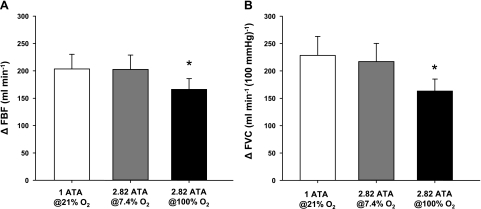Fig. 2.
Changes in forearm blood flow (ΔFBF) and forearm vascular conductance (ΔFVC) because of hyperoxic exercise. Rhythmic forearm exercise during hyperoxia (2.82 ATA at 100% O2; black bars) resulted in a reduced ΔFBF (A) and ΔFVC (B) compared with normoxic (1 ATA at 21% O2; white bars) and hyperbaric normoxic (2.82 ATA at 7.4% O2; gray bars) conditions. *P < 0.01 vs. normoxia and hyperbaric normoxia.

